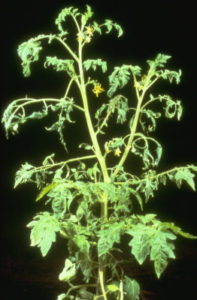I studied Verticillium in tomato plants in my aborted MSc degree.
Journalism was more fun, and my hands were black from the printing press instead of green (yes, I am that old).
 Laurel Hamers of Science News writes that instead of destroying its leafy hosts, one common plant virus takes a more backhanded approach to domination. It makes infected plants more attractive to pollinators, ensuring itself a continued supply of virus-susceptible plant hosts for generations to come.
Laurel Hamers of Science News writes that instead of destroying its leafy hosts, one common plant virus takes a more backhanded approach to domination. It makes infected plants more attractive to pollinators, ensuring itself a continued supply of virus-susceptible plant hosts for generations to come.
The strategy might be a way for the virus to discourage resistance from building up in the plant population, University of Cambridge biologist John Carr and colleagues report online August 11 in PLOS Pathogens.
“It looks like the pathogen is cheating a little bit —but in a way that helps its host,” says Carr.
Plants give off cocktails of volatile chemicals that send signals to pollinators, predators and other plants. Carr and his team found that tomato plants infected with cucumber mosaic virus gave off a different cocktail of these chemicals than non-infected plants — and that bumblebees preferred the infected plants’ brew.
That’s a small consolation for plants that have been stunted and blemished by cucumber mosaic virus. When infected tomato plants relied on self-fertilization, they produced fewer seeds on their own than their healthy counterparts. But when bumblebees helped out, infected plants’ seed production matched healthy ones.
The virus benefits, too, Carr says. By ensuring that sick plants can still reproduce, “those genes enabling susceptibility to the virus will stay in the population.” And plants that are resistant to the virus can’t gain the foothold that they could if all the sick plants died too soon.
The team also found that cucumber mosaic virus changes plants’ chemicals by disrupting their natural defenses against disease.
Normally, plants can identify when bits of foreign genetic material (like those from a virus) have worked their way inside. Specialized silencing enzymes snap into action and chop up the foreign invaders. But a cucumber mosaic virus protein called 2b disrupts this process by binding to the silencing molecules so that they can’t do their job, Carr and his colleagues found.
That lets the virus infect the plant more easily— and it also changes the way the plant turns its genes on and off. When the researchers tested a virus that didn’t have the gene for the 2b protein, the infected plants didn’t shift the chemicals they gave off like the plants infected with the fully functioning virus did.
The link between the 2b protein and volatile production is a major finding that could help scientists to better understand how viruses manipulate their hosts, says Andrew Stephenson, a biologist at Penn State University who wasn’t involved in the work.
But further research is needed to convincingly show that the increased pollination is really a fitness benefit for the plant, Stephenson says. Even though the infected plants produced more seeds, those seeds could be smaller and less likely to germinate, he says. And the shift in chemical production could lure aphids (which transmit the virus from plant to plant) just as much as bumblebees.
